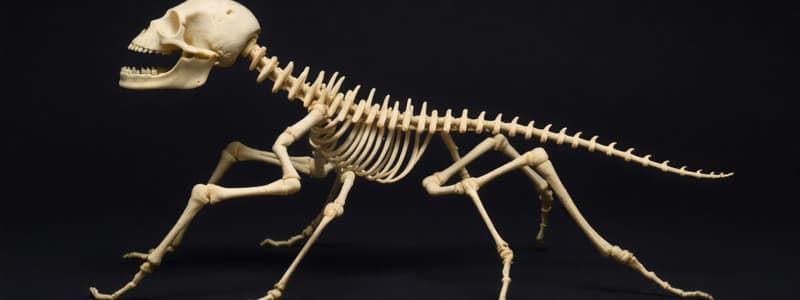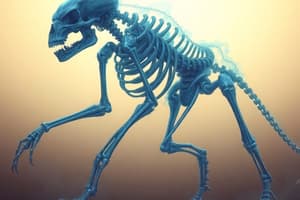Podcast
Questions and Answers
What distinguishes an exoskeleton from an endoskeleton?
What distinguishes an exoskeleton from an endoskeleton?
- An exoskeleton grows with the organism.
- An endoskeleton provides more flexibility.
- An exoskeleton is located outside the body. (correct)
- An endoskeleton is made of chitin.
Which of the following materials is NOT typically found in exoskeletons?
Which of the following materials is NOT typically found in exoskeletons?
- Keratin
- Bone (correct)
- Calcium carbonate
- Chitin
What is the primary function of both endoskeletons and exoskeletons?
What is the primary function of both endoskeletons and exoskeletons?
- To produce energy.
- To protect the body and internal organs. (correct)
- To provide movement.
- To regulate temperature.
What type of animals typically possess exoskeletons?
What type of animals typically possess exoskeletons?
How do most insects manage the growth of their exoskeletons?
How do most insects manage the growth of their exoskeletons?
What makes up the axial skeleton in vertebrates?
What makes up the axial skeleton in vertebrates?
Which characteristic is specific to endoskeletons?
Which characteristic is specific to endoskeletons?
Which of the following is an example of an animal with an endoskeleton?
Which of the following is an example of an animal with an endoskeleton?
What is a unique feature of the structure of exoskeletons?
What is a unique feature of the structure of exoskeletons?
How many bones does an adult human typically have?
How many bones does an adult human typically have?
Flashcards
Exoskeleton
Exoskeleton
An external skeleton that provides protection and support for the body, found in animals like insects, crabs and lobsters.
Endoskeleton
Endoskeleton
An internal skeleton that provides support and protection, found in animals like humans, dogs, fish and birds.
Chitin
Chitin
A strong but flexible material that makes up exoskeletons, giving them protection and flexibility.
Calcium carbonate
Calcium carbonate
Signup and view all the flashcards
Molting
Molting
Signup and view all the flashcards
Invertebrates
Invertebrates
Signup and view all the flashcards
Vertebrates
Vertebrates
Signup and view all the flashcards
Axial skeleton
Axial skeleton
Signup and view all the flashcards
Appendicular skeleton
Appendicular skeleton
Signup and view all the flashcards
Cartilage
Cartilage
Signup and view all the flashcards
Study Notes
Exoskeletons vs. Endoskeletons
- Exoskeleton: An external skeletal system; the skeleton is on the outside of the body. Examples include crabs, insects, lobsters.
- Endoskeleton: An internal skeletal system; the skeleton is inside the body. Examples include humans, dolphins, birds.
Skeletal Systems: Similarities
- Protection: Both exoskeletons and endoskeletons protect the body and internal organs.
- Movement: Both help the body move.
- Framework: Both provide a framework to give the body shape.
Exoskeleton Details
- Materials: Made of chitin and calcium carbonate.
- Chitin: Strong but flexible, allowing for movement.
- Calcium Carbonate: Provides hardness to the exoskeleton.
- Invertebrates: Most animals with exoskeletons are invertebrates (lacking a backbone).
- Insect Prevalence: Insects are the largest group with exoskeletons.
- Other Examples: Crabs, lobsters, shrimp, snails, and spiders also have exoskeletons.
- Growth Limitation: Exoskeletons do not grow with the animal. Some animals shed their exoskeleton (molt) to grow.
Endoskeleton Details
- Materials: Made of bones and cartilage (a type of hard tissue).
- Growth: Endoskeletons grow with the animal.
- Vertebrates: Animals with endoskeletons are vertebrates (have a backbone).
- Human Bone Count: Adult humans have more than 200 bones.
- Other Examples: Dolphins, whales, fish, and birds.
- Axial Skeleton: Part of the endoskeleton; protects vital organs like the brain and lungs. In humans, this includes the skull, backbone, and ribcage.
- Appendicular Skeleton: Part of the endoskeleton; provides shape and support for areas such as the legs and arms. In humans, this includes shoulder, arm, leg and pelvic bones.
Studying That Suits You
Use AI to generate personalized quizzes and flashcards to suit your learning preferences.




